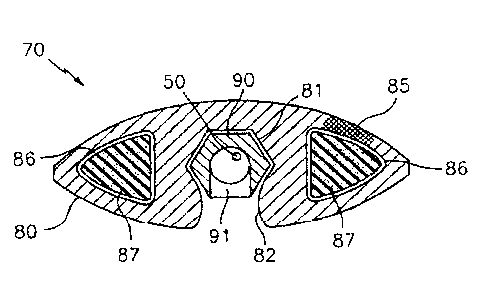Some of the information on this Web page has been provided by external sources. The Government of Canada is not responsible for the accuracy, reliability or currency of the information supplied by external sources. Users wishing to rely upon this information should consult directly with the source of the information. Content provided by external sources is not subject to official languages, privacy and accessibility requirements.
Any discrepancies in the text and image of the Claims and Abstract are due to differing posting times. Text of the Claims and Abstract are posted:
| (12) Patent: | (11) CA 2599042 |
|---|---|
| (54) English Title: | FLYER BOW WITH SEMI-ENCLOSED WIRE GUIDES |
| (54) French Title: | BALUSTRE A BROCHES AVEC GUIDES-FILS SEMI-ENCASTRES |
| Status: | Granted and Issued |
| (51) International Patent Classification (IPC): |
|
|---|---|
| (72) Inventors : |
|
| (73) Owners : |
|
| (71) Applicants : |
|
| (74) Agent: | NORTON ROSE FULBRIGHT CANADA LLP/S.E.N.C.R.L., S.R.L. |
| (74) Associate agent: | |
| (45) Issued: | 2013-12-17 |
| (86) PCT Filing Date: | 2006-02-27 |
| (87) Open to Public Inspection: | 2006-09-08 |
| Examination requested: | 2011-02-14 |
| Availability of licence: | N/A |
| Dedicated to the Public: | N/A |
| (25) Language of filing: | English |
| Patent Cooperation Treaty (PCT): | Yes |
|---|---|
| (86) PCT Filing Number: | PCT/US2006/007369 |
| (87) International Publication Number: | US2006007369 |
| (85) National Entry: | 2007-08-23 |
| (30) Application Priority Data: | |||||||||
|---|---|---|---|---|---|---|---|---|---|
|
Disclosed herein is a flyer bow (10) for use in a wire-twisting machine
including a body with an airfoil shaped (70) cross section, a recessed channel
(81) within the body and a series of wire guide inserts (91) retained within
the recessed channel. Further disclosed herein is a wire guide insert
including a tubular body having an exterior non-circular shape corresponding
to a similar non-circular shape of a channel and an exhaust opening in the
wire guide inserts.
La balustre à broche (10) de l'invention est à utiliser dans une machine à torsader comprenant un corps avec un profil aérodynamique (70), un canal en creux (81) dans le corps et une série de dispositifs de guide-fil (91) retenus dans le canal en creux. L'invention concerne également un dispositif de guide-fil comprenant un corps tubulaire possédant une forme extérieure non circulaire correspondant à une forme non circulaire similaire d'une rainure et d'une bouche de sortie d'air dans les dispositifs de guide-fil.
Note: Claims are shown in the official language in which they were submitted.
Note: Descriptions are shown in the official language in which they were submitted.

2024-08-01:As part of the Next Generation Patents (NGP) transition, the Canadian Patents Database (CPD) now contains a more detailed Event History, which replicates the Event Log of our new back-office solution.
Please note that "Inactive:" events refers to events no longer in use in our new back-office solution.
For a clearer understanding of the status of the application/patent presented on this page, the site Disclaimer , as well as the definitions for Patent , Event History , Maintenance Fee and Payment History should be consulted.
| Description | Date |
|---|---|
| Common Representative Appointed | 2019-10-30 |
| Common Representative Appointed | 2019-10-30 |
| Grant by Issuance | 2013-12-17 |
| Inactive: Cover page published | 2013-12-16 |
| Inactive: Final fee received | 2013-10-01 |
| Pre-grant | 2013-10-01 |
| Letter Sent | 2013-06-26 |
| Notice of Allowance is Issued | 2013-06-26 |
| Notice of Allowance is Issued | 2013-06-26 |
| Inactive: Approved for allowance (AFA) | 2013-06-20 |
| Amendment Received - Voluntary Amendment | 2013-05-01 |
| Inactive: S.30(2) Rules - Examiner requisition | 2012-11-01 |
| Amendment Received - Voluntary Amendment | 2011-07-07 |
| Inactive: Correspondence - Transfer | 2011-05-06 |
| Letter Sent | 2011-04-18 |
| Letter Sent | 2011-04-18 |
| Inactive: Single transfer | 2011-03-25 |
| Letter Sent | 2011-03-04 |
| Request for Examination Received | 2011-02-14 |
| Request for Examination Requirements Determined Compliant | 2011-02-14 |
| All Requirements for Examination Determined Compliant | 2011-02-14 |
| Request for Examination Received | 2011-02-14 |
| Letter Sent | 2008-08-11 |
| Inactive: Single transfer | 2008-05-13 |
| Inactive: Cover page published | 2007-11-15 |
| Inactive: Notice - National entry - No RFE | 2007-11-13 |
| Inactive: First IPC assigned | 2007-09-28 |
| Application Received - PCT | 2007-09-27 |
| National Entry Requirements Determined Compliant | 2007-08-23 |
| Application Published (Open to Public Inspection) | 2006-09-08 |
There is no abandonment history.
The last payment was received on 2013-02-04
Note : If the full payment has not been received on or before the date indicated, a further fee may be required which may be one of the following
Patent fees are adjusted on the 1st of January every year. The amounts above are the current amounts if received by December 31 of the current year.
Please refer to the CIPO
Patent Fees
web page to see all current fee amounts.
Note: Records showing the ownership history in alphabetical order.
| Current Owners on Record |
|---|
| KEIR MANUFACTURING, INC. |
| Past Owners on Record |
|---|
| DAVID PHELPS STRECKER |
| DOUGLAS ALLAN VOGE |
| SCOTT SCRANTON |